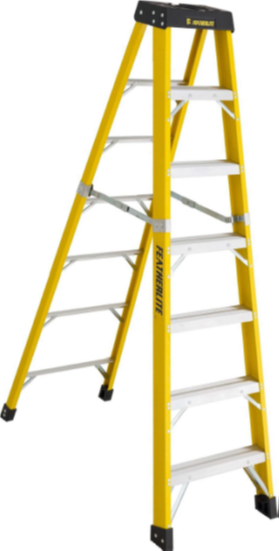18 Outcome 1: Access Equipment
Section Information
Outcome/Competency: You will be able to describe and select access equipment.
Timing: 1h
Rationale:
Why is it important for you to learn this skill?
Powerline technicians will often have to use access equipment such as ladders. It is important to understand how to safely use ladders as well as how to select the correct ladder for the job. This will reduce workplace injury and keep you safe.
Objectives:
To be competent in this area, the individual must be able to:
- Identify and describe different types of ladders
- Describe inspection and maintenance procedures
Learning Goals
- Demonstrate safe procedures used when setting up, maintaining, and using ladders
Introduction:
In this section you will learn about different types of ladders, safe ladder use, and how to address hazards. You will be presented with content, and then given a chance to test your understanding with short review exercises.
Instructions:
- Cover the following content in each topic as a group (either reading out loud or independently) then give an opportunity to answer any questions.
- Have students do the review questions independently, then take up answers.
Topic: Ladder Types (5m)
|
Figure 3 Step Ladder Attr.Featherliteladders.com |

Figure 2 Extension Ladder Attr. Featherliteladders.com |
Ladders are used extensively in electrical trades. Due to their length, they may pose a hazard when used near overhead circuits or energized equipment. For this reason, metal or metal reinforced ladders are not to be used in electrical trades. Electrically conductive ladders must not be used in the powerline trade.
Ladders in the electrical trade are either extension or step ladders. The materials they consist of are either epoxy based (fiberglass) or wood. Both of these materials offer insulation from electric shock; and therefore, offer some protection to a worker in the event of an accidental contact.
Topic: Safe Ladder Use and Addressing Hazards (10m)
A well maintained ladder is a safe ladder. Ladders should be kept clean to reduce the possibility of slipping and to prevent a path for current to flow should an electrical contact be made.
Ladders should always be inspected for defects (broken safety feet, cracks, etc.) before use. Anytime a ladder is found to be defective, it should be destroyed or immediately fixed to prevent someone else from using it and possibly getting hurt.
Anytime a ladder is moved or stored, it should be reduced to its minimum length. This will made it easier to handle or store and will prevent drops or knocks which may damage it.
Proper Ladder Use (15m)
Many accidents with ladders could have been avoided if proper usage was followed. First of all , ladders should be inspected for defects and replaced if any are found. All portable ladders must be equipped with safety feet. If there is still a possibility the ladder will slip, the ladder should be tied off or held by another employee. Step ladders must be fully opened when in use.
An employee must always face the ladder when climbing up or down and use both hands during the process. Climbers must never be worn and only one employee may be on a ladder at all time.
 When a ladder is moved in areas of overhead energized circuits, extreme care must be taken. The ladder must be carried in a horizontal position, with the ends of the ladder never being raised above hip level.
When a ladder is moved in areas of overhead energized circuits, extreme care must be taken. The ladder must be carried in a horizontal position, with the ends of the ladder never being raised above hip level.The most confusing rule, when working with ladders, is how close or far the base should be from the supporting surface. If the ladder is to close, it may flip over backwards when a worker shifts his weight. If it is too far away, the feet can lose grip and slide away from the supporting surface.
The rule of thumb for ladders is the base of the ladder should not be less than ¼ and not more than 1/3 of its length from the supporting surface.
This can also be stated or shown by two ratios:
- For every 4 feet up, it must go at least 1 foot out. Any closer it may topple backwards.
- For every 3 feet up, it can go no further out than 1 foot. The ladder may slide down the supporting structure.
Review Exercises: Access Equipment (30m)
|
T/F |
|
|
T/F |
|
|
|
|
|
T/F |
|
|
|
|
|
T/F |
|
|
T/F |
|
|
T/F |
|
|
T/F |
|
|
|
|
|
T/F |
|
|
|
|
|
T/F |
|
|
T/F |
|
|
T/F |
|
|
|
|
Answer Key
|
10. Horizontally and Hip |
|
11. False |
|
12. d |
|
13. False |
|
14. True |
|
15. False |
|
16. c |
|
|
|
|

